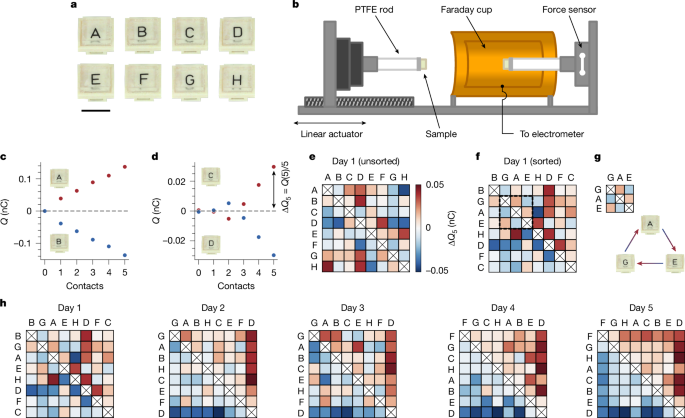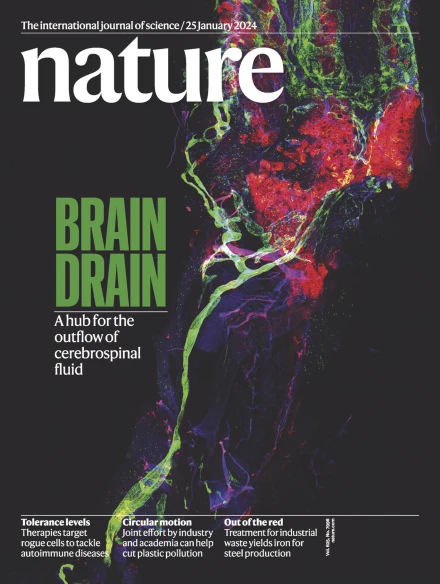Spontaneous ordering of identical materials into a triboelectric series
IF 50.5
1区 综合性期刊
Q1 MULTIDISCIPLINARY SCIENCES
引用次数: 0
Abstract
When two insulating, neutral materials are contacted and separated, they exchange electrical charge1. Experiments have long suggested that this ‘contact electrification’ is transitive, with different materials ordering into ‘triboelectric series’ based on the sign of charge acquired2. At the same time, the effect is plagued by unpredictability, preventing consensus on the mechanism and casting doubt on the rhyme and reason that series imply3. Here we expose an unanticipated connection between the unpredictability and order in contact electrification: nominally identical materials initially exchange charge randomly and intransitively, but—over repeated experiments—order into triboelectric series. We find that this evolution is driven by the act of contact itself—samples with more contacts in their history charge negatively to ones with fewer contacts. Capturing this ‘contact bias’ in a minimal model, we recreate both the initial randomness and ultimate order in numerical simulations and use it experimentally to force the appearance of a triboelectric series of our choosing. With a set of surface-sensitive techniques to search for the underlying alterations contact creates, we only find evidence of nanoscale morphological changes, pointing to a mechanism strongly coupled with mechanics. Our results highlight the centrality of contact history in contact electrification and suggest that focusing on the unpredictability that has long plagued the effect may hold the key to understanding it. Nominally identical materials are found to spontaneously order into triboelectric series over repeated processes, which is found to be driven by the act of contact itself using experiments as well as numerical simulations.


将相同的材料自发地排列成摩擦电系列
当两种绝缘的中性材料接触并分离时,它们交换电荷。长期以来的实验表明,这种“接触电气化”是可传递的,不同的材料根据所获得的电荷的符号排列成“摩擦电系列”。与此同时,这种效果也受到不可预测性的困扰,使得人们无法就其机制达成共识,并对剧集所隐含的韵律和原因产生怀疑。在这里,我们揭示了接触电气化的不可预测性和顺序之间的意想不到的联系:名义上相同的材料最初随机和非传递地交换电荷,但经过反复的实验,有序地变成了摩擦电系列。我们发现这种演变是由接触本身的行为驱动的——历史上接触较多的样本对接触较少的样本负电荷。在最小模型中捕获这种“接触偏差”,我们在数值模拟中重建了初始随机性和最终顺序,并在实验中使用它来强制出现我们选择的摩擦电系列。通过一系列表面敏感技术来寻找接触产生的潜在变化,我们只发现了纳米级形态变化的证据,指出了一种与力学紧密结合的机制。我们的研究结果强调了接触史在接触电气化中的中心地位,并建议关注长期困扰该效应的不可预测性可能是理解它的关键。
本文章由计算机程序翻译,如有差异,请以英文原文为准。
求助全文
约1分钟内获得全文
求助全文
来源期刊

Nature
综合性期刊-综合性期刊
CiteScore
90.00
自引率
1.20%
发文量
3652
审稿时长
3 months
期刊介绍:
Nature is a prestigious international journal that publishes peer-reviewed research in various scientific and technological fields. The selection of articles is based on criteria such as originality, importance, interdisciplinary relevance, timeliness, accessibility, elegance, and surprising conclusions. In addition to showcasing significant scientific advances, Nature delivers rapid, authoritative, insightful news, and interpretation of current and upcoming trends impacting science, scientists, and the broader public. The journal serves a dual purpose: firstly, to promptly share noteworthy scientific advances and foster discussions among scientists, and secondly, to ensure the swift dissemination of scientific results globally, emphasizing their significance for knowledge, culture, and daily life.
 求助内容:
求助内容: 应助结果提醒方式:
应助结果提醒方式:


